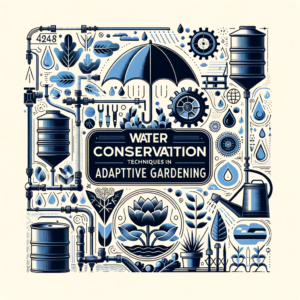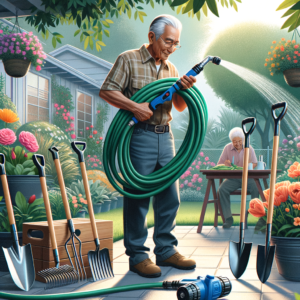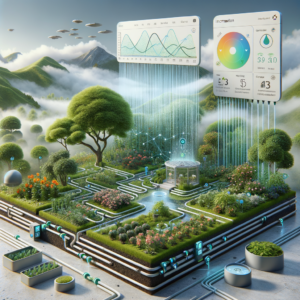In the realm of adaptive gardening, where ease of maintenance and efficiency are paramount, drip irrigation systems stand out as a game-changing solution for watering. These systems offer a method of precise, controlled water delivery that not only conserves resources but also significantly reduces the physical effort required in garden maintenance. This comprehensive guide will explore the world of drip irrigation, providing you with the knowledge to implement this effortless watering solution in your adaptive garden.
Understanding Drip Irrigation Systems
Drip irrigation is a low-pressure, low-volume watering method that delivers water directly to plant roots through a network of tubing and emitters. This system minimizes water waste and promotes optimal plant growth by providing consistent moisture levels.
Key Concepts:
| – Slow, steady water application |
|---|
- Targeted delivery to root zones
- Customizable to various garden layouts and plant needs
Benefits of Drip Irrigation for Adaptive Gardens
- Water Efficiency: Reduces water usage by up to 50% compared to traditional methods
- Labor Saving: Minimizes the need for manual watering
- Weed Reduction: Limits water to planted areas, discouraging weed growth
- Improved Plant Health: Consistent moisture levels promote robust growth
- Flexibility: Easily adaptable to various garden designs and plant types
- Soil Erosion Prevention: Gentle water application maintains soil structure
- Accessibility: Reduces the need for physical movement around the garden
Components of a Drip Irrigation System
- Water Source: Connection to a faucet or main water line
- Backflow Preventer: Prevents contamination of water supply
- Pressure Regulator: Reduces water pressure for optimal drip function
- Filter: Removes particles that could clog emitters
- Main Line: Primary water distribution tubing
- Drip Tubing: Smaller tubes that run along plant rows
- Emitters: Devices that release water at a slow, controlled rate
- End Caps: Seal the ends of tubing
- Timer: Automates watering schedules (optional but recommended)
Types of Drip Irrigation Systems
- In-Line Drip Systems:
- Emitters pre-installed in the tubing
- Ideal for row crops or evenly spaced plants
- External Emitter Systems:
- Emitters inserted into blank tubing
- Offers more flexibility in emitter placement
- Micro-Sprinkler Systems:
- Combines drip irrigation with small sprinklers
- Suitable for larger areas or plants that benefit from foliage watering
- Soaker Hoses:
- Porous hoses that seep water along their length
- Simple to install but less precise than other methods
Planning Your Drip Irrigation Layout
- Map Your Garden: Create a detailed plan of your garden layout
- Identify Plant Water Needs: Group plants with similar watering requirements
- Determine Water Source Location: Plan the system around your water access point
- Calculate System Capacity: Ensure your water source can support the entire system
- Consider Future Expansion: Plan for potential garden growth
- Zone Planning: Divide your garden into watering zones if necessary
Installation Process
- Gather Materials: Collect all necessary components and tools
- Install Backflow Preventer and Filter: Connect to your water source
- Lay Main Line: Position the primary water distribution tubing
- Connect Drip Lines: Attach smaller tubes to the main line
- Place Emitters: Install emitters near plant bases
- Secure Tubing: Use stakes or clips to hold tubing in place
- Install Timer: Set up an automatic timer for consistent watering
- Test the System: Run a test to check for leaks and proper water distribution
Maintenance and Troubleshooting
- Regular Inspections: Check for leaks, clogs, or damaged tubing
- Flushing the System: Periodically flush to remove sediment
- Emitter Cleaning: Clean or replace clogged emitters
- Winter Preparation: Drain the system in freezing climates
- Filter Maintenance: Clean or replace filters as needed
- Adjusting for Plant Growth: Modify emitter placement as plants mature
Customizing for Different Plant Needs
- Varying Emitter Flow Rates: Use different flow rates for diverse plant types
- Micro-Sprayers for Broad Areas: Incorporate for groundcovers or densely planted areas
- Adjustable Emitters: Allow for changes in water flow as plant needs evolve
- Multi-Port Emitters: Ideal for container gardens or closely spaced plants
- Specialized Emitters: Use options like foggers for humidity-loving plants
Integrating with Smart Garden Technologies
- Smart Controllers: Wi-Fi enabled timers for remote control
- Soil Moisture Sensors: Automate watering based on actual soil conditions
- Weather-Based Systems: Adjust watering schedules according to local weather data
- Mobile Apps: Monitor and control your system from your smartphone
- Integration with Home Automation: Incorporate into broader smart home systems
Cost Considerations and ROI
- Initial Investment: Upfront costs for components and installation
- Water Savings: Significant reduction in water bills over time
- Reduced Labor Costs: Less time spent on manual watering
- Improved Plant Health: Fewer losses due to under or overwatering
- Energy Savings: Lower water pumping needs compared to sprinkler systems
- Longevity: Properly maintained systems can last for many years
Environmental Impact
- Water Conservation: Dramatically reduces water waste
- Reduced Runoff: Minimizes water pollution from garden chemicals
- Energy Efficiency: Less energy used for water pumping and treatment
- Soil Health: Maintains soil structure and reduces erosion
- Plant Diversity: Allows for efficient watering of diverse plant types
- Chemical Reduction: Can decrease the need for fungicides by avoiding wet foliage
Conclusion
Drip irrigation systems offer an excellent solution for effortless watering in adaptive gardens. By providing precise, efficient water delivery, these systems not only conserve valuable resources but also significantly reduce the physical demands of garden maintenance. The initial investment in a drip irrigation system pays off through water savings, improved plant health, and the creation of a more manageable and enjoyable garden space.
For gardeners with mobility challenges or those seeking a low-maintenance approach, drip irrigation can be a game-changer. It allows for the cultivation of diverse and thriving gardens with minimal physical effort. As you implement a drip irrigation system, remember to tailor it to your specific garden needs and consider integrating smart technologies for even greater ease of use.
With proper planning, installation, and maintenance, a drip irrigation system can transform your adaptive garden into a water-efficient, flourishing oasis that brings joy and satisfaction with minimal effort.
FAQ
- Q: How often should I run my drip irrigation system? A: The frequency depends on your climate, soil type, and plant needs. Generally, longer, less frequent watering sessions are better than short, frequent ones.
- Q: Can drip irrigation work for container gardens? A: Yes, drip irrigation is excellent for containers. Use specialized emitters or micro-tubing for precise water delivery to pots.
- Q: Is it difficult to install a drip irrigation system? A: Basic systems can be a DIY project for those comfortable with simple tools. More complex systems might require professional installation.
- Q: How do I know if my plants are getting enough water with drip irrigation? A: Monitor your plants and soil moisture. Healthy plant growth and consistently moist (not waterlogged) soil are good indicators.
- Q: Can I use drip irrigation in areas with hard water? A: Yes, but you may need to clean emitters more frequently and consider using a water softener or filter to prevent mineral buildup.



